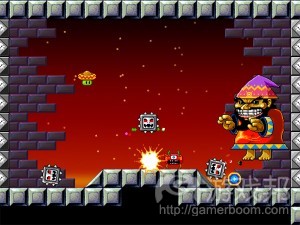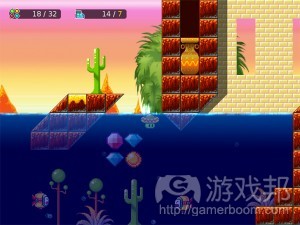Kumobius开发者阐述游戏开发过程
作者:Michelle Starr
墨尔本工作室Kumobius刚刚发行了第一款游戏《跳豆大冒险》,这是一款基于早式滚动平台的游戏,以“墨西哥跳豆”(游戏邦注:墨西哥跳豆是盛产在中美洲一带的Sebastiana Pavoniana矮灌木的种子)为主角。开发者Ivan Neeson,Tom Greenaway以及James Greenaway将具体谈论关于游戏创作的一些问题。
能否跟我们说说Kumobius的背景?你们在该公司分别扮演着何种角色以及Kumobius是如何发展起来的?是什么原因推动着你们去开发手机游戏?
我们是来自墨尔本的独立游戏开发工作室,总共只有三名成员。
James:过去10年里我一直扮演着插画师和美术家的角色。因为我很喜欢电子游戏,所以我总是会在游戏中寻找各种创作灵感。很多人跟我说过,我的作品总是非常精细,就像是一个填满各种内容的复杂世界;而这刚好与电子游戏中的关卡布局非常相似。
Tom:我的一生都在进行游戏开发。年轻的时候,我会使用一些简易的工具创建小游戏。并从那时起我开始认识到程序设计是一种非常重要的技巧,从而开始磨练自己的这一技巧。
在Kumobius中,我主要从事一些管理工作,如衡量一项内容的可行性,观察任何游戏设计的可用性和易接近性等。我同样也需要创造并维持那些我们在关卡构建中所需要的工具,这就意味着我在《跳豆大冒险》中需要协助James进行关卡设计等任务。
Ivan:我已踏入游戏产业多年,并曾经致力于一些AAA级游戏的创造,如针对于iPhone和iPad的《极品飞车:变速》。我也参与了最优秀的一款游戏《小马伙伴2》的制作过程。
2010年,经由一个共同的好友引荐我们聚在了一起;并且从那时起我们开始利用下班或者周末等空闲时间共同制作游戏。
《跳豆大冒险》好像是你们的第一款游戏。能否详细描述下这款游戏以及你们是如何创造出这款特殊的游戏?
一开始我们便明确要创造一款拥有简单控制的游戏。我们都清楚,大多数触屏设备的屏幕都很难控制,而不能真正发挥设备本身的功能。
随后我们便想到了经典的无限滚动平台游戏,并尝试着添加一些不同的内容。在围绕着一些基本的理念而创造出游戏原型并尝试着玩游戏之后,我们决定替换其中的一些机制,从而让角色在游戏中始终保持跳跃。
结果证明我们这么做是对的,而我们也最终决定使用触屏而不是回转移,虽然后者也能够提供精确的平台控制。如此,不管是游戏控制还是玩家移动都变得更加精简,从而让游戏整体看来更加自然。
手机游戏市场竞争非常激烈。而你们的《跳豆大冒险》又能够提供给玩家哪些其它游戏所不具备的内容?
我们的游戏玩法具有一定的深度,而同时我们的游戏控制又非常简单,让玩家能够快速掌握。所以这款游戏的特色便是“容易学习,难以精通。”而很多游戏却不能同时遵循这两方面内容。
比起让游戏拥有一些随机生成的阶段或提供“无限的游戏玩法”,我们选择事先设定好50个结构有序的游戏关卡。同时我们还为玩家创造了3个成就收集层面,让他们能够一步一步深入挖掘,从而提高游戏的重玩价值。
其中一个成就是“Jump Par”,主要是针对于喜欢老式游戏的玩家而设计的。也就是那些在童年时期玩过《超级马里奥》或《索尼克》的玩家都会很快就熟悉这一成就机制。
玩家可以尝试着通过最少的跳跃而完成每一个阶段,所以这种设置有点像高尔夫球的玩法。同时也要求玩家使用更多技巧并了解他们所需要面对的阶段。如果玩家能够做到这些,那么至少能够说明他们对游戏感到满意。
在创造《跳豆大冒险》时所面临的最大挑战是什么?而你们又是如何克服它?
从技术方面来看,我们在创造《跳豆大冒险》过程中建立起了一个健全的引擎以及一整套的开发工具。从理论上来看,这能够帮助我们更加快速地创作并扩展新游戏。我们是在开发初期便明确了这一决定,虽然这么做需要我们一开始便投入更多的时间和精力,但是对于我们今后的扩展却具有非常大的帮助。
而从游戏设计来看,我们所面临的最大挑战便是如何为我们的第一个游戏世界设计关卡。关于“第一个世界”的创造我们反反复复进行了4次修改,直到最终对游戏的进程以及玩家的游戏体验都感到满意为止。我们必须确保最初的游戏体验既能够让玩家感到愉悦,也能够提供给他们一定的挑战。
你们认为一款真正优秀的手机游戏需要具备哪些基本要素?
易接近性,即让玩家一开始能够容易掌握游戏。通过简单的游戏体验而快速告知玩家游戏的玩法以及游戏规则。同时你还需要了解你的用户;玩家会在路途中,等待列车的时候或者交通工具上玩手机游戏。所以你必须确保你的游戏模式能够让玩家方便地游戏。
当我们开始创造《跳豆大冒险》时,起初的游戏原型拥有比成品游戏更大规模,但是最终我们发现这种设置并不可行。过长的关卡并不适合手机游戏玩家,同时也会与我们的“Jump Par”成就产生矛盾。所以我们便开始缩减这些关卡,创造出较小但是更加紧凑的阶段,从而让玩家能够更好地集中注意力。到现在为止的游戏更新中,玩家共拥有50个关卡进行探索和挑战。
相对于掌机游戏和PC游戏的开发者,你是否发现手机游戏开发的不同?而这些不同元素是好还是坏?
Ivan:这就要根据不同人的不同目标而判断了,但是就目前来看,我认为手机平台是最适合于那些刚刚起步的独立游戏开发者。
PC平台能够帮助我们更好地学习如何制作游戏。在这里有许多非常出色的游戏引擎,并且开发者在此进行调试与解决问题的周转时间也非常之快。除此之外,因为现在几乎人人都拥有自己的PC,如此便大大节省了游戏的装配成本。
然而PC游戏的出售所面临的情况却完全不同。发行并销售独立的PC游戏并不是件易事。所以创造PC游戏对于独立开发者,特别是那些刚刚开始创造自己的第一款商业游戏的人来说并不是一个合适的选择。
掌机就更不适合独立游戏工作室了。制作掌机游戏所必须的装备成本都非常高,除非你认识一些掌机游戏制作者并且他们愿意提供给你一定的帮助。一些支持游戏下载的新型掌机和装置虽然能够降低整个游戏开发过程的难度,但是比起手机平台来说,这里还是一个难以逾越的领域。
所以对于独立游戏开发者来说,手机是现今最合适的游戏创造平台(以及销售平台)。这一平台不仅拥有优秀的API,同时其强大的基础设施也能够帮助你更好地发行游戏并与玩家维系起紧密的联系。
能否提供给那些梦想建立属于自己的手机游戏工作室的开发者一些建议?
Tom:我先说说较现实的资金基础问题:如果你有资格获得政府的补助金,那就一定要努力去争取。在过去,澳大利亚政府总是会资助一些小型企业或游戏开发工作室。
所以,好好思考你的第一款游戏;不要总是以自己的想法去约束游戏,因为这么做会让你将思维禁锢在某些内容上,并制造出一些难以解决的问题。你最好先从一些小范围的内容开始,或者围绕那些你所熟悉的理念或类型,并在开发过程中不断完善并改变。
最后,你必须重视团队的合作力量。虽然一个人也能够获得成功,但是你可能会因此感到孤独,并且当你在面对一开始的挑战时,友情总是能够发挥无穷的作用。
Ivan:如果你只是个独立的程序设计员,那么你需要做的第一件事便是寻找一名优秀的美工人员。当然了,优秀的游戏玩法也很重要,但是很多时候,好看的游戏外表能够更好地推动游戏的销售。
James:努力做自己,并创造自己想要的游戏。游戏就像是艺术品或电影,如果你能够充满激情地开发游戏,那么玩家必将能够从游戏中感受到你的这种激情。
Kumobius今后的发展目标是什么?
我们有很多想法。在开始下一款游戏的创造前我们将花更多时间去创建游戏原型。
最近,我们参加了2012年Global Game Jam(游戏邦注:世界上最大规模的团体游戏创作活动),并在与墨尔本当地的游戏竞争中摘得了最佳游戏殊荣。我们真的很高兴能够获得这个奖项,因为在这48个小时以上的活动中,我们见识了许多优秀的游戏。现在我们的网站上已经开始免费提供《跳豆大冒险》的PC和Mac版本的下载。
从这款游戏的开发中我们真的学到了很多。包括平台的作用,App Store的动态化,游戏设计的一般原则,以及更多关于玩家的了解。而我们将会把这些经验与教训进一步应用于下一款游戏的开发中。
(本文为游戏邦/gamerboom.com编译,拒绝任何不保留版权的转载,如需转载请联系:游戏邦)
Game Dev Stories: Kumobius
By Michelle Starr February 3, 2012
Melbourne studio Kumobius has just released its first game: Bean’s Quest, an old-school side-scrolling platform game starring a Mexican jumping bean. Come behind the scenes as we talk to developers Ivan Neeson, Tom Greenaway and James Greenaway about their creation.
Can you tell us a bit about the background of Kumobius? Who are you, and how did Kumobius come to be? What led you to mobile gaming?
We are a three-man indie game-development studio in Melbourne. Our three members are:
James: I’ve worked as an illustrator and artist for about 10 years. I love video games, and they’ve always been a big inspiration in my work. People have told me my art is very detailed, like intricate worlds full of things; a bit like the layout of a level in a video game.
Tom: I’ve experimented with game development my whole life. When I was young, I would build tiny games with simple tools. It made me appreciate how important programming can be as a skill, and I pursued it since then.
At Kumobius I do a lot of the administration of the company, considering the feasibility of the work, and always questioning the usability or accessibility of any game design. I also build and maintain the tools we use to work on the levels, which also means I have helped James with the actual level designs for Bean’s Quest.
Ivan: I’ve worked in the game industry for quite a few years, working on some AAA titles such as Need for Speed: Shift for iPhone and iPad. I also worked on the greatest game ever made: Pony Friends 2.
We met each other through a mutual friend in 2010; from then, we worked on the game casually after work and on weekends.
It looks like Bean’s Quest is your first game. Can you explain a little bit about it and how you arrived at this particular game?
When we first started, we knew that we wanted to create a game that had simple controls. We all pretty much agreed that most on-screen controls for touch-based devices aren’t accessible, and didn’t really match the paradigm of the device.
We started thinking about those classic “always running” infinite side-scrolling games, and trying to add something different. After prototyping and playing around with a few ideas, however, we decided to try flipping the mechanic so that the character is always jumping.
It turned out to work really well, and we decided to use the touchscreen rather than the gyroscope, as well — this allowed for very precise platforming. From that point on, it was simply a matter of refining the controls and the players’ movement, so that it feels natural.
There’s massive competition in the mobile-gaming market. What do you think Bean’s Quest offers that other games do not?
There’s a lot of depth in the gameplay, but at the same time the controls are so simple that people can pick it up instantly. So it has that “easy to learn, hard to master” aspect. A lot of games end up going for only one of those ideas, and miss the other.
Rather than games with randomly generated stages and supposedly “infinite gameplay”, we have 50 very carefully structured stages. We have created three layers of achievements for players to collect, which provides more depth and replay value.
One of the achievements is called “Jump Par”, and it’s designed specifically for old-school gamers. People who played Super Mario or Sonic in their childhood will be right at home with this achievement.
Every stage can be achieved in a minimum number of jumps, so it’s a bit like a golf par. It requires a lot of skill and understanding of the stage to achieve. People who can do it tell us it’s very satisfying.
What was the biggest challenge in creating Bean’s Quest? How did you overcome it?
From a technical point of view, we have built a very robust engine and set of tools alongside Bean’s Quest. In theory, we can now expand and build new games even faster. This was a decision we made early on, and, while it created more work for us to begin with, it should pay off as we expand.
In terms of game design, we think our biggest challenge was coming up with level designs for our first world. We re-made “World 1″ about four times before we were finally happy with the way the game progressed and taught the player. You really need to make the initial experience pleasurable, but still challenging; it’s a fine line.
What do you think is the essential ingredient in a truly awesome mobile game?
Accessibility; it should be easy to learn to start with. Simple experiences that teach the player what’s going on and what the rules are, quickly. You also need to be aware of your audience; mobile games are played while in transit, waiting for trains or connecting transport. So your game’s format should suit that to a degree.
An example is when we started Bean’s Quest — our first prototype had much larger stages than the final product, but we found this didn’t work so well. The levels were too long for the mobile audience, and also conflicted with the Jump Par achievement we touched on earlier. We refined those level designs down to smaller stages that are much tighter and keep your attention. Now, with the final update, there are 50 of these stages to explore and conquer.
What have you found different about mobile-gaming development, as opposed to console and PC development? Is it better or worse?
Ivan: Well, it all depends on what your goals are, but in general I think that mobile is currently the best platform for indie game developers just starting out.
The PC is a fantastic platform for getting started learning how to create games. There are tons of great game engines out there, and the turnaround time for debugging and fixing problems is very fast. As a bonus, everyone probably already has a PC, so the set-up cost is very low.
Getting your PC game out there on the market, however, is an entirely different story. There is currently no easy way to distribute and sell indie games for the PC. I think this makes it a bad choice for indie developers, especially those who are just starting out with their first commercial title.
Consoles are pretty much out of the question for young indie studios. The cost for all the required equipment is usually very high, and that’s assuming you can even form a relationship with console makers. Newer consoles and handhelds with downloadable games are making this process a little easier, but it’s still nowhere near as seamless as mobile platforms.
I think mobile is currently the best place to create (and, more importantly, sell) games as an indie developer. Not only are the APIs for these platforms really good, but the infrastructure for getting your game out there and into customers’ hands is as simple as it could be.
What advice would you offer aspiring devs looking to set up their own mobile-game studio?
Tom: I’ll start from a cash-flow perspective: if you’re eligible for any government grants, then look into them. The Australian Government has been pretty helpful for small businesses and games in the past. Ideally, you want to build something quickly that will generate income to test the waters.
So then, picking your first project is tough; don’t try to make the game you “always wanted to make”, because you will fail in some way and you’ll get hung up on those problems. You’re better off starting with small scope, an idea or genre you feel you understand well, and keep moving forward in development.
Lastly, a team is always good. People can be successful solo, but you can feel isolated — camaraderie is really important when facing all the challenges of starting a studio.
Ivan: If you’re a solo programmer, the number-one thing you need to get is a great artist. Of course, great gameplay is important, but — most of the time — better-looking games will sell more.
James: Don’t be afraid to be yourselves and make the games you really want to make. Games are like art or movies; if you develop a game you’re passionate about, it will show in the end product.
What’s next for Kumobius?
We have lots of ideas. We’re going to look at prototyping more before we jump into our next game.
Recently, though, we participated in the 2012 Global Game Jam — we won the best game prize for our entry in the local competition here in Melbourne, Australia. That was quite humbling, as there were lots of great games built in those 48 hours. The game is currently available for free on PC and Mac here on our website.
We definitely learned a lot from Bean’s Quest. Both how the platform works, the dynamics of the App Store, game-design principles in general, learning even more about the audience. We’ll apply as much as we can to our next project.
Having said that, there’s a lot more to learn — so we’ll be constantly adapting, we’re sure.(source:cnet)











































 闽公网安备35020302001549号
闽公网安备35020302001549号